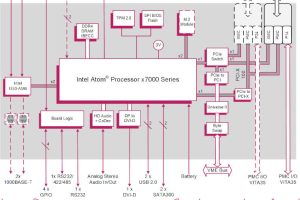JDI was formed last year from the small and medium LCD businesses of Hitachi, Sony and Toshiba – with $2.6bn from the Innovation Network Corporation of Japan, making INCJ its largest shareholder.
At the same time, JDI created KOE around Hitachi’s industrial display design lab and factories in Taiwan.
The Taiwan factories never did make the display ‘glass’ (the actual LCD sandwich), but brought in glass from Hitachi’s Japanese operations, then added backlights, connectors, and anything else needed to make finished display modules. Backlighting is a particular skill inherited by KOE, said KOE Europe’s general manager Mark Stanley
As KOE, the Taiwan facilities now have access to glass from Japanese factories owned by Hitachi, Toshiba and Sony, as well as local Taiwanese suppliers.
For example, in 2013 KOE will introduce a 6.4in WVGA (800×480) using glass from what was formerly a Sony factory – a format not available from former Hitachi plants.
Why re-use glass designed for other applications? – Because industrial displays do not ship in the huge volumes required for cost-effective glass development, said Stanley.
Closer to its traditional supplier, in the fourth quarter KOE will be shipping a wide-screen 12.3″ (half SXGA, 1280 x 512) industrial TFT module based on glass manufactured for car instrument clusters at JDI’s ex-Hitachi plant.
KOE’s extra-rugged industrial displays from automotive glass are going to carry ‘Rugged+’ branding. Others in the rugged range are a 5.8in WQVGA, two 7.0in WVGA (CMOS or LVDS interface), and an 8.0in WVGA. All operate over -30 to 80°C.
Another technology that has come from consumer display development is a wide viewing angle LCD that does not change colour with viewing angle.
The technology has been dubbed ‘IPS-like’. Even though it is based on a TN (twisted nematic) stack rather than expensive IPS (in-plane switching), it gets some of the benefits IPS has brought to iPads and their like.
“It maintains colour homogeneity at different viewing angles, so if you have a tall rack of medical pumps which display red for alert conditions, you don’t have to be right in front each display to see if it is red,” said KOE technical product manger Mark Stephenson.
Projected capacitive touch is another technology that KOE has transferred from consumer displays for industrial users – initially in two-touch form allowing touch zoom and rotation.
Stephenson points out that adopting capacitive touch is not trivial. The display has to be set-up for, and calibrated in, the finished product – to allow for local EMI levels for example.
“We have drivers for Linux, Windows and Android. We will work with customers on their applications,” he said, adding that new-generation touch controller chips will add some self-calibration when they make it through to industrial products.
Good news for KOE internally is that JDI is building J1, a huge LCD fab in Mobara Japan. As this comes on stream it will handle high-volume displays and fee-up space in older fabs for the production of industrial display glass.
Links forged with Taiwanese glass suppliers has already paid off in the form of KOE ‘Lite+’ branded display modules. Although intended to be lower-cost options in its range, some of these have better than average specifications – including operation beyond the normal industrial temperature range.
Bringing the industrial product ranges of three companies together is inevitably going to mean overlap, and as a consequence the firm is dropping some products.
“Everyone who is not getting a form fit and function replacement already knows,” said Mark Stanley.
 Electronics Weekly Electronics Design & Components Tech News
Electronics Weekly Electronics Design & Components Tech News



